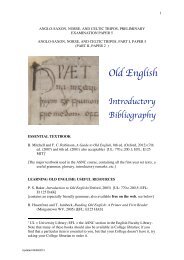Scandinavian history in the Viking age - Department of Anglo-Saxon ...
Scandinavian history in the Viking age - Department of Anglo-Saxon ...
Scandinavian history in the Viking age - Department of Anglo-Saxon ...
Create successful ePaper yourself
Turn your PDF publications into a flip-book with our unique Google optimized e-Paper software.
<strong>Scand<strong>in</strong>avian</strong> History <strong>in</strong> <strong>the</strong> Vik<strong>in</strong>g Age<br />
Norway<br />
As elsewhere <strong>in</strong> ma<strong>in</strong>land Scand<strong>in</strong>avia, <strong>the</strong> first lawcodes from Norway are prov<strong>in</strong>cial ra<strong>the</strong>r than<br />
national <strong>in</strong> scope. The traditions recorded <strong>in</strong> <strong>the</strong> k<strong>in</strong>gs’ sagas (B290 ff.) credit various k<strong>in</strong>gs with sett<strong>in</strong>g<br />
up some <strong>of</strong> <strong>the</strong>se legal prov<strong>in</strong>ces, and <strong>the</strong> references to Hakon <strong>the</strong> good’s lawmak<strong>in</strong>g <strong>in</strong> <strong>the</strong><br />
Bers²glisvísur (B546g) may confirm a royal <strong>in</strong>terest <strong>in</strong> legislation by <strong>the</strong> tenth century. The first<br />
Christian law is said to have been <strong>in</strong>troduced by Olaf Haraldsson around <strong>the</strong> 1020s (E70 ff., L172).<br />
However, <strong>the</strong> manuscripts rema<strong>in</strong><strong>in</strong>g date from no earlier than <strong>the</strong> late twelfth century, and secular codes<br />
are only fully preserved for two <strong>of</strong> <strong>the</strong> Norwegian prov<strong>in</strong>ces.<br />
[B700] The basic edition rema<strong>in</strong>s: R. Keyser et al., Norges gamle Love <strong>in</strong>dtil 1387 udgivne ifölge<br />
<strong>of</strong>fentlig Foranstaltn<strong>in</strong>g, 5 vols (1846-95) [UL 593:01.b.3.1-5]. Attempts to re-edit some <strong>of</strong> <strong>the</strong> codes<br />
have begun to bear fruit; see B. Eithun et al., Den eldre Gulat<strong>in</strong>gslova, Norrøne tekster 6 (1994) [UL<br />
280.c.95.88]<br />
[B701] For <strong>the</strong> two major secular codes <strong>in</strong> translation, see L.M. Larson, The earliest Norwegian laws,<br />
be<strong>in</strong>g <strong>the</strong> Gulath<strong>in</strong>g law and <strong>the</strong> Frostath<strong>in</strong>g law, Records <strong>of</strong> civilization: sources and studies 20 (1935)<br />
[UL 280.c.90.14].<br />
[B702] H. Refsum, ‘The Gulat<strong>in</strong>g’, (A41):68-72; E. Gunnes, ‘Erkebiskop Øyste<strong>in</strong> og Frostat<strong>in</strong>gsloven’,<br />
NHT 53 (1974), 109-21 (E.s.); I. Kleiva, Gulat<strong>in</strong>get: t<strong>in</strong>gstader og lovverk (1980) [UL 280.c.95.68]; M.<br />
R<strong>in</strong>dal, ‘Dei eldste fragmenta av dei norske landskapslovene’, (O48):130-36<br />
Denmark<br />
The three Danish prov<strong>in</strong>cial codes are similarly only preserved <strong>in</strong> thirteenth-century manuscripts, and<br />
show <strong>the</strong> slow growth <strong>of</strong> royal authority over legislation.<br />
[B705] The series Danmarks gamle landskabslove [UL 597:2.b.90.1 ff.] consists <strong>of</strong> numerous volumes<br />
prepared by a variety <strong>of</strong> editors, broken down <strong>in</strong>to prov<strong>in</strong>ces: first Skåne, I:1 Skånske lov: text I-III<br />
(1933) and I:2 Skånske lov: Anders Sunesøns parafrase, Skånske kirkelov m.m. (1933); <strong>the</strong>n Jutland, II<br />
Jyske lov: text I, NkS 295 8o (1933), III Jyske lov: text II-IV (1951), IV Jyske lov: text V-VI (1945); and<br />
f<strong>in</strong>ally Zealand, V Eriks sjællandske lov: text I-II (1936), VI Eriks sjællandske lov: text III-V (1937), VII<br />
Valdemars sjællandske lov: arvebog og orbodemål (1942), VIII Valdemars sjællandske lov: ældre og<br />
yngre redaktion samt sjællandske kirkelov (1941)<br />
[B706] P.J. Jørgensen, Dansk retshistorie: retskildernes og forfatn<strong>in</strong>gsrettens historie <strong>in</strong>dtil sidste<br />
halvdel af det 17. aarhundrede, 5th edn (1971) [UL 280.c.95.10]; O. Fenger, Gammeldansk ret: dansk<br />
rets historie i oldtid og middelalder (1983) [UL 280.d.95.5]<br />
[B707] Of some <strong>in</strong>terest is <strong>the</strong> Danish ‘court law’ from <strong>the</strong> late twelfth century, which exists <strong>in</strong> both<br />
Lat<strong>in</strong> and vernacular versions; it claims to reflect <strong>the</strong> code drawn up by Knut after his conquest <strong>of</strong><br />
England (D100 ff.) for his household or hirð, although this is now thought a bit optimistic. The Lat<strong>in</strong> text<br />
comes from <strong>the</strong> hand <strong>of</strong> Sven Aggesen (B656) and is known as <strong>the</strong> Lex Castrensis; text: (B635): I,64-93.<br />
For <strong>the</strong> vernacular Vederloven, see E. Kroman, Den danske rigslovgivn<strong>in</strong>g <strong>in</strong>dtil 1400 (1971), 1-5 [UL<br />
280.b.95.10]. A full text, translation, and commentary can be found <strong>in</strong> (B656)<br />
Sweden<br />
The Swedish prov<strong>in</strong>cial codes have come under particular scrut<strong>in</strong>y <strong>in</strong> <strong>the</strong> past due to <strong>the</strong> assumption that<br />
<strong>the</strong>ir langu<strong>age</strong> betrays a dist<strong>in</strong>ctively ancient body <strong>of</strong> material; this view is now largely out <strong>of</strong> fashion, cf.<br />
(B692) (a key study, with heavy emphasis on <strong>the</strong> Gutal<strong>age</strong>n) and (B682).<br />
[B710] The basic corpus can be found <strong>in</strong> C.J. Schlyter et al., Saml<strong>in</strong>g af Sweriges gamla lagar, 13 vols<br />
(1827-77) [UL 595:2.b.80.1 ff.]. This ra<strong>the</strong>r antiquated edition can be supplemented by more recent<br />
editions <strong>of</strong> <strong>in</strong>dividual codes, <strong>of</strong> which only a selection is given here: [a] H. Pipp<strong>in</strong>g, Guta lag och Guta<br />
saga, jämte ordbok, SUGNL 33 (1905-07) [UL 752:01.d.2.31]; [b] E. Wessén, Äldre Västgötal<strong>age</strong>n,<br />
Nordisk filologi: texter och läroböcker för universitetsstudier A:9 (1954) [UL 752:01.d.4.9]; [c] S.<br />
Henn<strong>in</strong>g, Upplandsl<strong>age</strong>n enligt codex Esplunda, SSF 169-70 (1934) [UL 755:1.c.1.63] and<br />
Upplandsl<strong>age</strong>n enligt cod. Holm. B 199 och 1607 års utgåva, SSF 240, 242 (1967-69) [UL<br />
755:1.c.1.112]<br />
[B711] A very useful Swedish transl. <strong>of</strong> all <strong>the</strong> prov<strong>in</strong>cial codes packed with useful <strong>in</strong>troductions and<br />
notes is: Å. Holmbäck and E. Wessén, Svenska landskapslagar, 5 vols (1933-46) [UL 280.c.90.17-21]<br />
50






